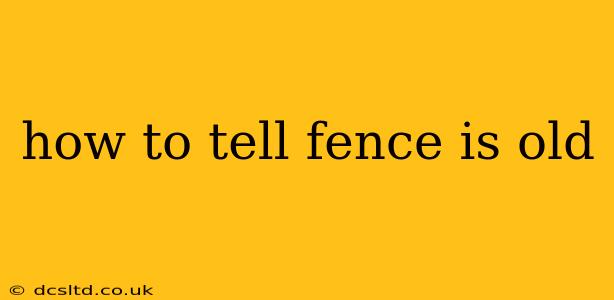A well-maintained fence adds curb appeal and enhances property security. However, over time, even the sturdiest fence will show its age. Knowing when to replace your fence can save you from costly repairs and ensure the ongoing safety and aesthetic value of your property. This guide will help you identify the signs of an aging fence and determine if it's time for a replacement.
What are the Signs of an Old Fence?
Several indicators can reveal the age and condition of your fence. Let's delve into the most common ones:
1. Deteriorating Wood:
This is often the most obvious sign. Look for:
- Rotting or Decay: Check for soft, spongy wood, especially at the base of posts and rails. This indicates water damage and potential structural weakness.
- Cracks and Splits: Significant cracks or splits in the wood, particularly in posts and rails, signify weakening and potential failure.
- Insect Infestation: Look for evidence of termites or carpenter ants, often indicated by small holes or tunnels in the wood. These pests can severely weaken the fence's structure.
- Peeling or Blistering Paint: While not a structural issue in itself, peeling or blistering paint often accompanies aged wood and suggests underlying damage that needs attention.
2. Loose or Damaged Posts:
Fence posts are the backbone of your fence. Assess their condition carefully:
- Leaning or Tilting Posts: A leaning post indicates a weakened foundation or significant soil erosion. This compromises the overall stability of the fence section.
- Loose or Wobbly Posts: Posts that move easily when pushed suggest loosening in the ground or damaged anchoring.
- Rot at the Base: Similar to rotting rails, rotting at the base of posts is a serious problem that necessitates immediate attention.
3. Sagging or Misaligned Sections:
Over time, the weight of the fence and exposure to the elements can cause sagging or misalignment:
- Sagging Rails or Panels: Sagging indicates weakened support structures, possibly due to rot, insect damage, or poor installation.
- Misaligned Sections: Sections that are no longer straight or level indicate structural issues that may be difficult and expensive to repair.
4. Gaps and Loose Connections:
Check for gaps between the fence boards and also between the boards and the posts:
- Wide Gaps Between Boards: This reduces the fence's privacy and security and indicates weakening of the structure.
- Loose Nails or Screws: Loose fasteners are a common issue in older fences and can easily be fixed, but if widespread it's a signal of general wear and tear.
5. Deteriorating Metal:
If you have a metal fence, look for:
- Rust and Corrosion: Extensive rust compromises the structural integrity and can lead to breakage.
- Bent or Damaged Metal: Bent or damaged sections pose safety hazards and are difficult to repair perfectly.
How Old is Too Old?
There's no magic number for how many years a fence lasts before needing replacement. Factors like material, climate, and maintenance significantly impact a fence's lifespan. However, a well-maintained wooden fence might last 15-20 years, while a vinyl fence could last 30 years or more. If you find multiple signs of deterioration mentioned above, even if your fence is relatively "young," it may be time to consider replacing it.
What to Do if Your Fence is Old
If your assessment reveals several issues, it's probably time to consider a replacement rather than costly and potentially ineffective repairs. A new fence offers improved aesthetics, enhanced safety, and long-term cost savings. Consult with a fencing professional for advice on choosing the right materials and design for your needs.
